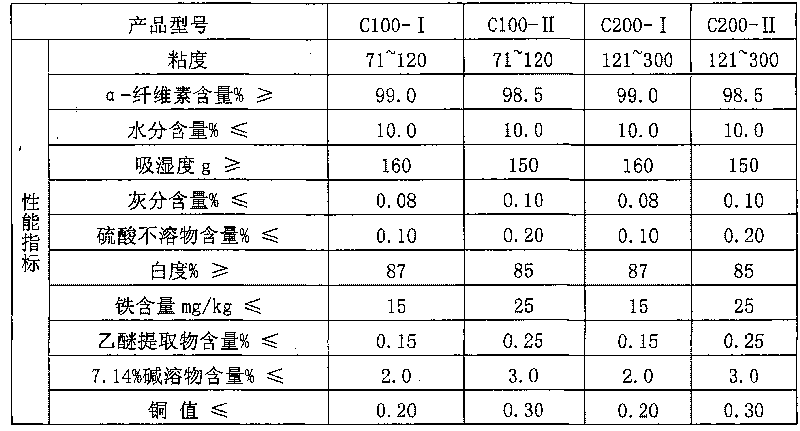Method for producing acetate fiber bamboo pulp
A technology of acetate fiber and production method, applied in the direction of artificial filament made of viscose, etc., to achieve the effect of short process and short production cycle
- Summary
- Abstract
- Description
- Claims
- Application Information
AI Technical Summary
Problems solved by technology
Method used
Image
Examples
Embodiment 1
[0076] The cooking process condition of unbleached unbleached natural color bamboo pulp in the digester: liquid ratio: 1: 3, with alkali amount NaOH (NaOH meter): 10% (to absolute dry bamboo pulp weight percent), Na 2 S (NaOH meter): 0.1% (according to the amount of NaOH added), heating conditions: heating up to 130°C, time 60min, heat preservation 120min, continue to heat up to 150°C, heat up time 60min, heat preservation 180min, heat preservation is completed, continue to heat up to 175 ℃, keep warm for 180 minutes, after the heat preservation is completed, cool down and discharge the materials, and the cooking is completed after the materials are discharged.
[0077] The pulp quality index after cooking in this example: α-cellulose: 95%, polymerization degree: 2500.
[0078] The refining process is carried out in the alkalization tower, the slurry concentration is 4%, the amount of alkali used: 12%, the temperature: 20°C, the residence time: 2h, after the alkalization is co...
Embodiment 2
[0080] The cooking process condition of unbleached unbleached bamboo pulp in the digester: liquid ratio: 1: 5, the amount of alkali used NaOH (NaOH meter): 30% (to the absolute dry bamboo pulp weight percentage), heating up condition: be warming up to 120 ℃ , time 50min, heat preservation 60min, continue to heat up to 140°C, heat up time 45min, heat preservation 160min, heat preservation is completed, continue to heat up to 170°C, heat preservation 60min, heat preservation is completed, cool down and discharge, cooking is completed after discharge.
[0081] The pulp quality index after cooking in this example: α-cellulose: 96%, polymerization degree: 2000.
[0082] The refining process is carried out in the alkalization tower, the slurry concentration is 6%, the amount of alkali used: 10%, the temperature: 25°C, the residence time: 2h, after the alkalization is completed: send it to a vacuum pulp washer or a rotary screen thickener for washing , washed to pH7-9.
Embodiment 3
[0084] The cooking process condition of unbleached unbleached natural color bamboo pulp in the digester: liquid ratio: 1: 6, with alkali amount NaOH (NaOH meter): 50% (to absolute dry bamboo pulp weight percent), Na 2 S (in terms of NaOH): 15% (in terms of NaOH addition), 0.01% of anthraquinone (in terms of absolute dry bamboo slurry weight percentage), heating conditions: heating up to 115 ° C, time 60 min, insulation 30 min, continue to heat up to 135 ° C , the heating time is 45 minutes, and the heat preservation is 120 minutes.
[0085] The pulp quality index after cooking in this example: α-cellulose: 96%, polymerization degree: 2000.
[0086] The refining process is carried out in the alkalization tower, the slurry concentration is 12%, the amount of alkali used: 8%, the temperature: 25°C, the residence time: 2h, after the alkalization is completed: send it to a vacuum pulp washer or a rotary screen thickener for washing , washed to pH7-9.
PUM
| Property | Measurement | Unit |
|---|---|---|
| degree of polymerization | aaaaa | aaaaa |
| degree of polymerization | aaaaa | aaaaa |
Abstract
Description
Claims
Application Information
 Login to View More
Login to View More - R&D
- Intellectual Property
- Life Sciences
- Materials
- Tech Scout
- Unparalleled Data Quality
- Higher Quality Content
- 60% Fewer Hallucinations
Browse by: Latest US Patents, China's latest patents, Technical Efficacy Thesaurus, Application Domain, Technology Topic, Popular Technical Reports.
© 2025 PatSnap. All rights reserved.Legal|Privacy policy|Modern Slavery Act Transparency Statement|Sitemap|About US| Contact US: help@patsnap.com

